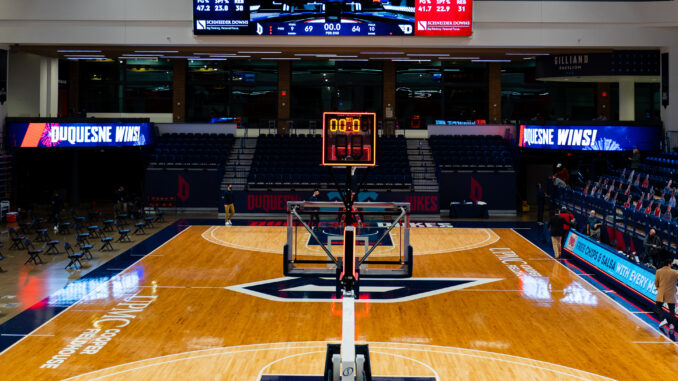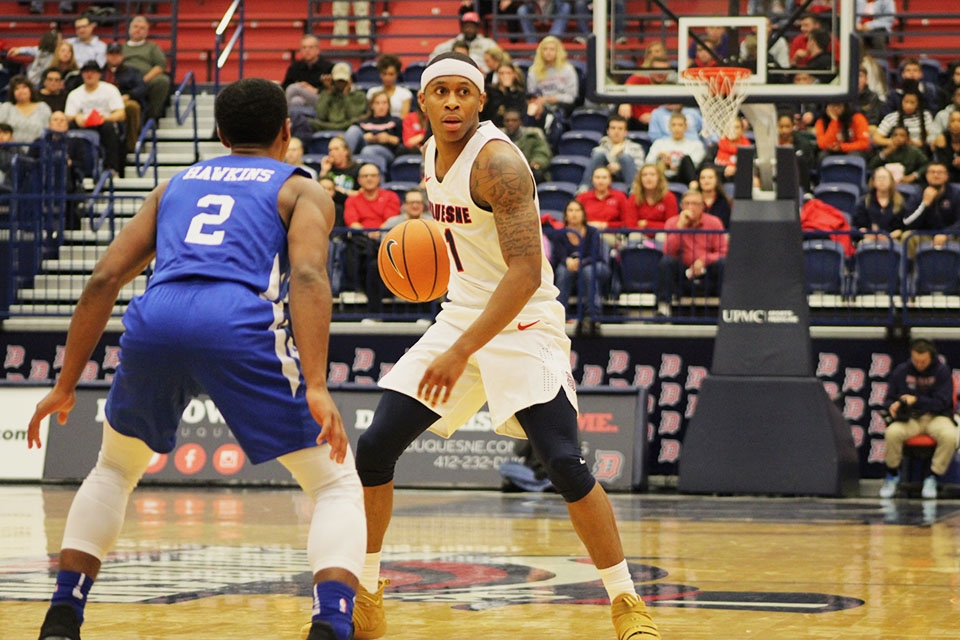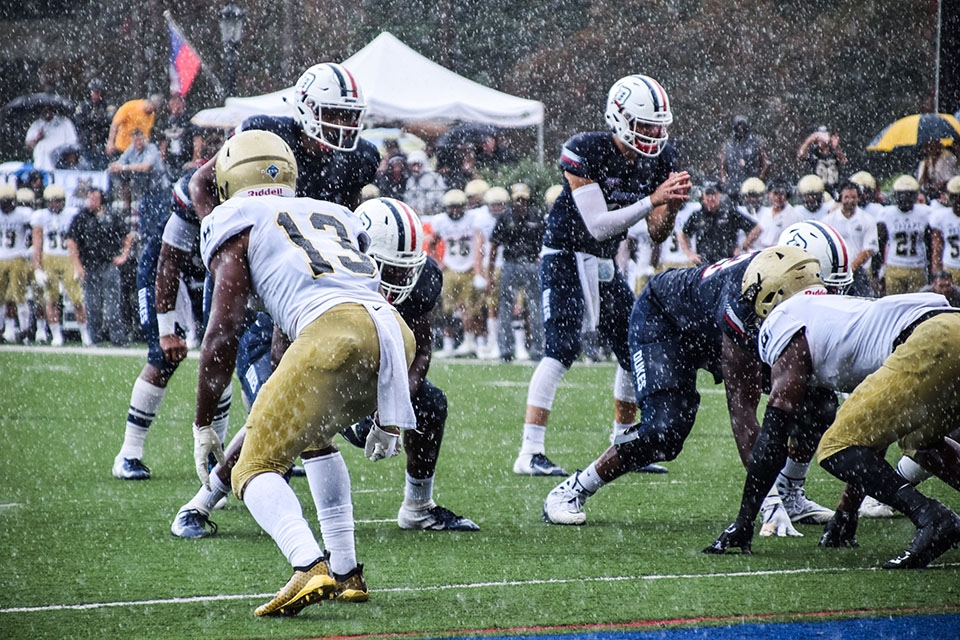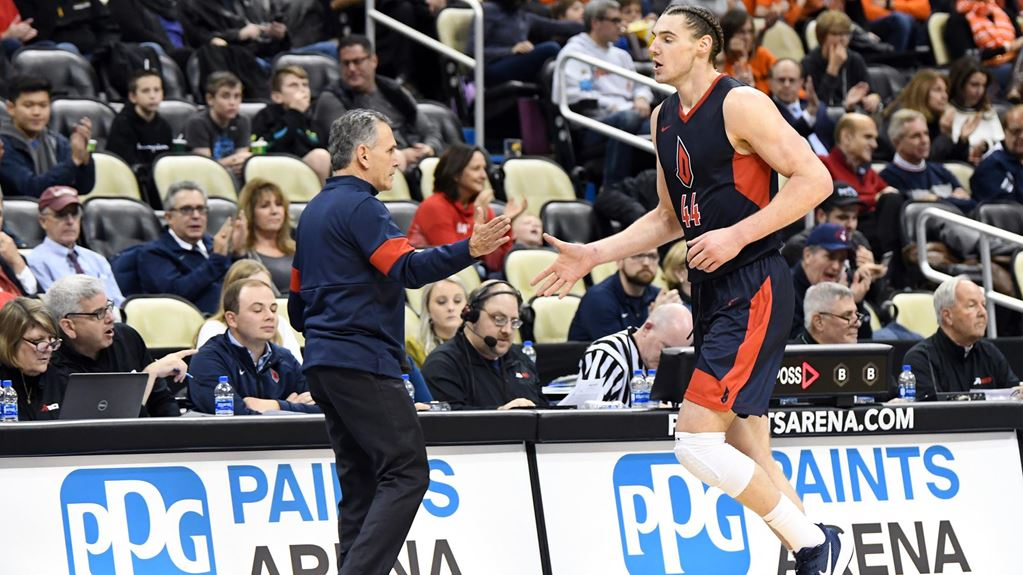
Adam Lindner | Sports Editor
Feb. 4, 2021
Duquesne waited a long time for this day to come.
Of course, construction began on the UPMC Cooper Fieldhouse — Duquesne University’s gleaming new arena — in March 2019. The school’s basketball and volleyball teams went without a home venue for the entirety of the 2019-20 school year, hosting “home” games at nearby locales including PPG Paints Arena, Robert Morris University, La Roche University and various area high schools.
After all, the Cooper Fieldhouse — located on the site of the old A.J. Palumbo Center — was originally slated to open in time for the teams’ prospective 2020-21 seasons. One year away from campus in exchange for a revitalized gym seemed like a fair trade for all parties involved.
The Fieldhouse’s construction coincided with a major retooling of Duquesne’s athletic brand, complete with a new typeface, logo and color scheme (welcome to the club, electric blue). Excitement was mounting on the Bluff as it related to university athletics.
Enter: Global pandemic.
COVID-19’s proliferation in March 2020 halted everything at once, sending college students across the country home. The plug was pulled on collegiate athletics, cancelling March Madness and stopping spring sports just as they began. Arena construction, naturally, was put on hold.
The building’s assembly resumed in May following a nearly two-month-long hiatus, but even then, the construction team faced “logistical challenges” once it returned to work.
For the longest time, the Fieldhouse appeared to be seemingly half-done, leaving the project — and, by extension, the school’s teams — in limbo.
Accordingly, the men’s and women’s basketball teams would eventually embark on their second-straight seasons as nomads, opting for neutral-site or road games when not hosting makeshift “home” contests.
The women’s volleyball team, which typically competes during the fall, bided time in preparation for its season that will begin next week (the Atlantic 10 moved some fall sports, including volleyball, to spring).
Sheesh, talk about good timing.
The Fieldhouse — named after 1950 Duquesne graduate Chuck Cooper, who was both the first Black man to play in a college basketball game south of the Mason-Dixon Line and to be drafted into the NBA — officially opened Feb. 2, when the men’s basketball team beat Dayton, 69-64, in its first game on campus since March 9, 2019. The game, broadcast nationally on ESPN2, saw Duquesne best a Flyers program that it doesn’t often beat. Freshman forward Chad Baker nailed a 3-pointer 41 seconds into the game, notching the Fieldhouse’s first-ever basket and giving Duquesne a lead it would never relinquish.
Fifty students were permitted to attend Tuesday’s grand opening, plus some players’ family and friends. In all, 212 people attended the arena’s long-awaited christening.
The truth, though?
The truth is Duquesne waited a hell of a lot longer than 22 months for the Fieldhouse’s completion. Even before plans for the Fieldhouse were announced in late 2018, change was needed in order for Duquesne to consistently compete at the highest level. It was evident.
“We weren’t going to win with the old building. We weren’t,” Athletic Director Dave Harper told reporters earlier this week.
The new barn — one that Harper called “transformative” and men’s hoops coach Keith Dambrot donned the “perfect building for Duquesne” — came complete with many of the amenities found at high-major venues, including:
1. Two high-definition Daktronics video boards, one of which is ginormous
2. Six suites and 55 club-level seats, both of which appear to be professional-grade
3. Enhanced concession areas (Harper said construction contractor P.J. Dick joked that Duquesne may have built the largest bar in Pittsburgh)
4. A modernized, booming sound system
5. Four “fan corners” with impeccable sightlines
6. Large windows on the building’s exterior, allowing for phenomenal views of Pittsburgh’s skyline
The men’s hoops team inaugurated its new building admirably on Tuesday, earning a wire-to-wire victory over last season’s conference champions.
The contest’s final tally insinuates that the game was closer than it truly was. Duquesne led by as many as 22 points in the game’s second half and was never seriously threatened by Dayton’s attempt to come back.
Admittedly, it was a lot to take in.
Patrons of the former Palumbo Center, which opened in 1988, will remember many things about the Dukes’ old digs. Chief among them, perhaps, is the losing legacy Duquesne left in the building.
Since the Palumbo Center’s erection, Duquesne’s men’s team has failed to qualify for the NCAA Tournament. Duquesne hasn’t enjoyed a single March Madness since 1977, when Dambrot was 19-years-old and Norm Nixon was still a Duke.
Things are different now.
For the first time in a long time, Duquesne can say the same.
“The wrap on Duquesne in the past has been, ‘They’ve never won, they can’t win, they haven’t been to the NCAA Tournament in 1,000 years. Coaches get fired, there’s no commitment from the school,’” Dambrot said.
“If you don’t commit, you can’t win. You can’t consistently sustain anything,” he continued. “People can think it’s the coach, but it’s not the coach when you lose for as many years as Duquesne lost. They’ve had some good coaches here. They just didn’t have enough in the program.”




